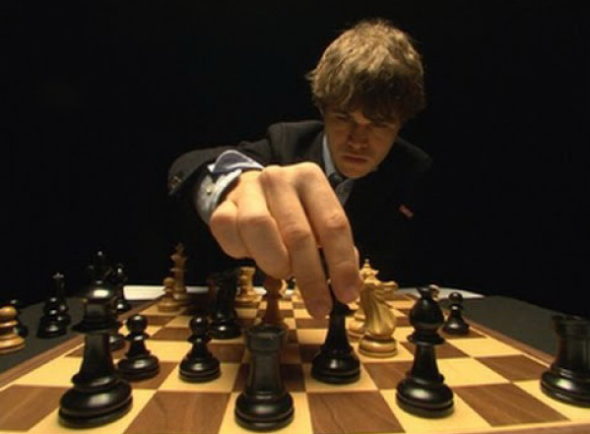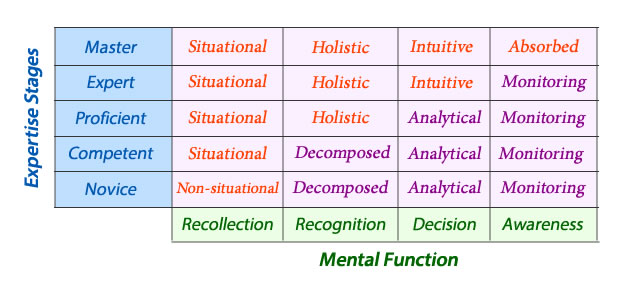5-Stage Model (Dreyfus & Dreyfus, 1980)
Which Dreyfus’ Model is correct? You may have come across an alternative Dreyfus’ Model that lists Novice, Advanced Beginner, Competent, Proficient, and Expert. That model (summarized by Michael Eraut in 1994) is inconsistent with Dreyfus’ original paper (see explanation).
[New (Jan 2020): I am currently working on a book chapter for a new project. Apparently Dreyfus (2004) made use of a 5-stage model that includes the Advanced Beginner but without the Master stage from the original model. I am checking with S. Dreyfus to see if he will revise the 5-stage model into one with 6 stages — so as to include both the Advanced Beginners and the Master. I strongly believe the Master stage should never have been removed — as you will see from below.)

In education, training, and operation research, the prevalent explanation for how learners acquire skills through formal instruction and practice is offered by Dreyfus & Dreyfus, (1980; link). This model was originally created for military research and described four binary qualities of mental activities in skill acquisition:
- Recollection (non-situational or situational),
- Recognition (decomposed or holistic),
- Decision (analytical or intuitive), and
- Awareness (monitoring or absorbed).
Dreyfus and Dreyfus distributed the four qualities over five consecutive stages of expertise: Novice, Competent, Proficient, Expert, and Master (see Figure below).
At the stage of Novice, individuals often (blindly) follow rules as given, without context, with no sense of responsibility beyond following the rules exactly. At the stage of Competence, individuals learn to organize principles to quickly access the particular rules that are relevant to the specific task at hand. This stage is characterized by active decision-making in choosing a certain course of action. The stage of Proficiency is reached when individuals begin to develop intuition to guide their decisions and devise their own rules to formulate plans.
The next two stages of Expert and Master must come with practice over a much longer period of time when the procedure to be learned is ingrained into long-term memory through pattern-recognition. The demonstration of skills will eventually become implicit, automated, and seemingly effortless — the sign of a true master. The overall progression is, thus, from rigid adherence to rules (novice) to an increasingly intuitive mode of reasoning based on tacit knowledge.

Figure 1: Model of Skill Acquisition (Dreyfus & Dreyfus, 1980)
3-Phase Model (Fitts & Posner, 1967)
Fitts & Posner’s model (1967) proposed that (physical) learning can be divided into 3 phases:
- Cognitive phase: In this phase, learners need to break down the desired skill into smaller different parts and understand how these parts come together as a whole for the correct performance of the task. The formation of schemas (the way an individual organizes the different parts into a whole) is important in directing the acquisition process.
- Associative phase: In this phase, learners repeatedly practice the tasks until patterns of responding emerge. This is the stage where learners figure out what works and what doesn’t. Effective actions are kept and ineffective actions are dropped. The overall actions of the skills are learned or automated as a learner’s sensory system acquires the accurate spatial and symbolic data required for the completion of the skills. The number of important stimuli associated with a task will determine how long it takes to complete this phase.
- Autonomous phase (or Procedural phase): this phase involves perfecting the skill acquisition. The ability to discriminate important from unimportant stimuli is made quicker and the less cognitive process is required because the skill has become automated. Important to this phase of the model is experience and factual knowledge stored for the observed skill.
4-stage “Predictive Cycle” Model (Tadlock & Stone, 2005)
The model proposed by Tadlock and Stone (2005) differs significantly from Fitts and Posner’s in that it does not require a conscious understanding of a skill’s components. Rather, the learner is only required to be consciously aware of a concept of the desired end result. The “Predictive Cycle” model includes the following stages:
- Attempt,
- Fail,
- Implicitly analyze the result, and
- Implicitly decide how to change the next attempt so that success is achieved.
The stages are repeated over and over until the learner builds or remodels the neural network to guide an activity appropriately and accurately without conscious thought. As individuals repeat this cycle, they will gradually increase their performance by weeding out unnecessary steps, keeping only the effective ones. This model has been successfully applied to reading remediation (Scott, Nelsestuen, Autio, Deussen, & Hanita, 2010).
3-stage shu-ha-ri (しゅはり、守破離) Model
The Masters of many Japanese art forms (e.g., tea ceremony, martial art, opera) adhere to a 3-stage skill acquisition model called shu-ha-ri (しゅはり、守破離). These stages have a close connection with the various “procedural instructions and skills” associated with dō (道) — a procedural training path that spans many years.Note: dō (道) can be transliterated as either the Way, or the Path — as in the “prescribed” procedural training path for a number of “art forms” including martial arts, cooking, calligraphy, etc.
For example, Japanese martial arts are often conducted in training grounds (i.e., classroom) called dōjō (道場). Students of the martial arts would train under the tutelage of a Sensei (or Master Teacher) for a period of time, eventually, graduate (leave) to open their own dōjō (道場). In this context, the three stages of shu-ha-ri (しゅはり、守破離) can be perceived as the learning experience of a student whose goal is to master ‘the Way’ (dō).
- shu (守): Keeping with the Path — Students must follow strictly the instructions of the Sensei/Master Teacher.
- ha (破): Breaking from the Path — Students who become proficient in the instructions are now allowed to explore new ways to improve self/skill.
- ri (離): Leaving the Path — Students who achieve Expert or Master levels are ready to leave (and branch out) to start their own dōjō.
In comparison to the “Predictive Cycle” model, shu (守) incorporates the first two steps (1 & 2) of Attempt and Fail, while ha (破) incorporates the last two steps (3 & 4) of Analyzing the result and Deciding how to change for improvement. In comparison to Fitts and Posner’s model, shu (守) would be the same as the Cognitive Phase, while ha (破) is equivalent to the Associative Phase.
Combining the Models: Competency-based Training
From a training and improvement perspective, trainers are seldom required to take an individual from Novice all the way to the Expert or Master level. It would be expecting too much as the time available for training (courses) is often limited to a few months or weeks (if not days). Hence, it would be more realistic to expect to teach the Novices the basic Ways (or “moves”) and the thinking processes involved in how to go about learning new things (i.e., meta-cognition skills). Ultimately, the purpose of such training is to learn the basic skills, enough to perform a job. Accuracy and proficiency should naturally come from real-world (workplace) practices.
In this sense, a short-term training can be deemed successful when an individual (1a) is capable of performing the required task (1b) within a reasonable time frame, (2) being able to judge whether the task performed is up-to-par, (3) having some idea about how to improve the accuracy and/or proficiency, so as to prevent (financial) losses, or endangering themselves and others. For instance, a medic is expected to perform a suture correctly and within a certain time frame if she is to be deployed, and a qualified pilot should be able to take off and land a plane safely in any weather condition within a certain time frame. Virtual environments and serious games are excellent options for this purpose because the learners will not accidentally harm themselves or others in the process.
Since the training of Experts and Masters requires a very long time, short-term training only addresses the skill acquisition from Novice to Proficient. Combining the various models, we have:
- Novice stage — learners should become familiarized with the basic instructions, practice them (mentally and physically, where appropriate), and keep trying (despite failures) until they have a good command of the basic moves. As newbies, they are expected to make mistakes and be unsure of the correct ways to do things. The training goal for Novices in this stage is for them to connect basic moves into a rudiment “course of action” — recognizable as a complete course with appropriate “start” and “end” points. This stage is consistent with Stage 1 of Fitts and Posner, Stage 1 and 2 of Tadlock and Stone, and Stage 1 of shu-ha-ri (守破離). [keywords: expect to fail, repetition, correction, basic instruction, practice, connecting tasks to procedure]
- Competent stage — learners begin to explore new ways of performing the procedures, with determination. The goal is to practice deliberately with a purpose to improve the execution of procedures with accuracy and proficiency. Learners should be capable of self-analysis to mentally determine if the changes are signs of improvement or not. Learners should be exposed to varying difficulties, and changing conditions of the procedures, to expose them to the most commonly encountered scenarios at the workplace. Actions that lead to improvement should be retained whereas those that are not, discarded or modified. This particular stage is consistent throughout the various models and easily recognizable as: (a) Stage 2 of Fitts & Posner, (b) Stage 3 & 4 of Tadlock and Stone, and (c) Stage 2 of shu-ha-ri (守破離) [keywords: persistence, motivation, meta-cognition, self-analysis, improvement, formative evaluation]
- Proficient stage — learners achieved basic proficiency in the skills and know some improvement tactics. To determine if the learners are competent enough to join the workforce (equivalent to competency-based training) (see next section), some kind of test or assessment may be needed to evaluate if baselines of accuracy and proficiency have been attained. Are they sufficiently better than an untrained person? Is the training program effective? Have they reached the bare minimum to join the workforce and (hopefully) be productive? Graduates may further improve themselves by seeking new lessons, new teachers, or take part in a tournament to determine their ranking in the community. However, this remains largely a personal choice (motivation). [keywords: assessment, competency-based training, likely-expert, summative evaluation]
Determined learners can continue the learning journey to eventually become Experts and Masters capable of teaching others, but that remains a largely personal decision.
Interestingly, medical education has started changing into a competency-based model. This is a marked departure from the time-based Flexner-style approach (i.e., 6 years + 1-year residency) from before. Perhaps the medical schools finally realize the need to ensure medical students who are entering the profession are indeed competent in their job? The Proficient Stage mentioned above is exactly what is needed in competency-based training.
As expected, the push towards competency-based education will require new assessments and new approaches to analyzing assessment results. When we apply competency-based training to the virtual environment, the same is true: We will need new assessment metrics and methods to analyze the obtained data for assessment.
Resources:
- Dreyfus & Dreyfus (1980). A five-stage model of the mental activities involved in directed skill acquisition. [PDF]
- https://en.wikipedia.org/wiki/Dreyfus_model_of_skill_acquisition
- http://www.royalcollege.ca/portal/page/portal/rc/resources/cbme
- https://en.wikipedia.org/wiki/Shuhari
- https://en.wikipedia.org/wiki/Japanese_martial_arts
- https://en.wikipedia.org/wiki/dōjō